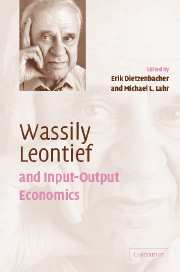Book contents
- Frontmatter
- Contents
- List of contributors
- List of figures
- List of tables
- Preface
- Part I Reflections on input-output economics
- 1 A portrait of the master as a young man
- 2 Leontief's “magnificent machine” and other contributions to applied economics
- 3 Leontief and the future of the world economy
- 4 International trade: evolution in the thought and analysis of Wassily Leontief
- 5 Leontief's input-output table and the French Development Plan
- 6 Leontief and dynamic regional models
- 7 Experiences with input-output and isomorphic analytical tools in spatial economics
- 8 Leontief and Schumpeter: a joint heritage with surprises
- 9 Some highlights in the life of Wassily Leontief – an interview with Estelle and Wassily Leontief
- Part II Perspectives of input-output economics
- Subject index
- Author index
6 - Leontief and dynamic regional models
Published online by Cambridge University Press: 22 September 2009
- Frontmatter
- Contents
- List of contributors
- List of figures
- List of tables
- Preface
- Part I Reflections on input-output economics
- 1 A portrait of the master as a young man
- 2 Leontief's “magnificent machine” and other contributions to applied economics
- 3 Leontief and the future of the world economy
- 4 International trade: evolution in the thought and analysis of Wassily Leontief
- 5 Leontief's input-output table and the French Development Plan
- 6 Leontief and dynamic regional models
- 7 Experiences with input-output and isomorphic analytical tools in spatial economics
- 8 Leontief and Schumpeter: a joint heritage with surprises
- 9 Some highlights in the life of Wassily Leontief – an interview with Estelle and Wassily Leontief
- Part II Perspectives of input-output economics
- Subject index
- Author index
Summary
Dynamics of the input-output system
The original edition of The Structure of American Economy, 1919–1929 did not mention economic dynamics (Leontief, 1941). A fairly complete exposition of dynamic economic theory, in an input-output framework, was presented to the American Economic Association (AEA) by Leontief in 1949, and later included as chapter D in the enlarged version of The Structure of American Economy, 1919–1939 (Leontief, 1951).
Leontief and several of his associates continued to make major advances in input-output analysis, which were brought together in a major publication (see Leontief et al., 1953). In this volume Leontief described open and closed, static, comparative static, and dynamic models. He also summarized the work he had been doing in the development of spatial models.
The basis of any input-output system is a transactions table: a two-way ordering of all interindustry sales and purchases during a given time period (usually a year). To complete the system a column of sales to ultimate users (or final demand) is added on the right-hand side of the transactions table, and a corresponding row, called value added (or payments sectors), is included at the bottom of the table. This is the raw material of an input-output model, from which a number of coefficients are calculated and used for a variety of analytical purposes (for further details at an elementary level, see Miernyk, 1965, pp. 9 and 149). Constructing transactions tables is costly and time-consuming. National tables are assembled by central statistical agencies.
- Type
- Chapter
- Information
- Wassily Leontief and Input-Output Economics , pp. 90 - 101Publisher: Cambridge University PressPrint publication year: 2004
- 2
- Cited by



